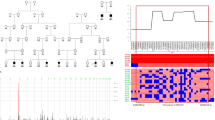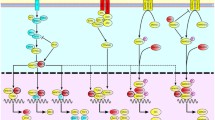Abstract
Microphthalmia/anophthalmia is a clinically heterogeneous disorder of eye formation, ranging from small size of a single eye to complete bilateral absence of ocular tissues. The genetic defect underlying isolated autosomal recessive microphthalmia/anophthalmia is yet unclear. We studied four families (two of Arab origin, one of Bedouin origin, and one of Persian-Jewish origin) with autosomal recessive microphthalmia/anophthalmia and no associated eye anomalies, and one Syrian–Jewish family with associated colobomas. Assuming a founder effect in each of the families, we performed homozygosity mapping using polymorphic markers adjacent to human homologues of genes known to be associated with eye absence in various species, namely EYA1, EYA2, EYA3, SIX4, SIX6, PAX6 and CHX10. No association was found with EYA1, EYA2, EYA3, SIX6 or PAX6. In two families, linkage analysis was consistent with possible association with SIX4, but no mutations were found in the coding region of the gene or its flanking intron sequences. In three of the five families, linkage analysis followed by sequencing demonstrated that affected individuals in each family were homozygous for a different CHX10 aberration: a mutation in the CVC domain and a deletion of the homeobox domain were found in two Arab families, and a mutation in the donor-acceptor site in the first intron in the Syrian-Jewish family. There was phenotypic variation between families having different mutations, but no significant phenotypic variation within each family. It has been previously shown that mutations in a particular nucleotide in CHX10 are associated with an autosomal recessive syndrome of microphthalmia/anophthalmia with iris colobomas and cataracts in two families. We now show that different mutations in other domains of the same gene underlie isolated microphthalmia/anophthalmia.



Similar content being viewed by others

References
Bessant DAR, Anwar K, Khaliq S, Hameed AM, Ismail M, Payne AM, Mehdi SQ, Bhattacharya SS (1999) Phenotype of autosomal recessive congenital microphthalmia mapping to chromosome 14q32. Br J Ophthalmol 83:919–922
Burmeister M, Novak J, Liang MY, Basu S, Ploder L, Hawes NL, Vidgen D, Hoover F, Goldman D, Kalnins VI, Roderick TH, Taylor BA, Hankin MH, McInnes RR (1996) Ocular retardation mouse caused by Chx10 homeobox null allele: impaired retinal progenitor proliferation and bipolar cell differentiation. Nat Genet 12:376–384
Chen CM, Cepko CL (2000) Expression of Chx10 and Chx10-1 in the developing chicken retina. Mech Dev 90:293–297
Fantes J, Ragge NK, Lynch SA, McGill NI, Collin JR, Howard-Peebles PN, Hayward C, Vivian AJ, Williamson K, van Heyningen V, FitzPatrick DR (2003) Mutations in SOX2 cause anophthalmia. Nat Genet 33:461–463
Green ES, Stubbs JL, Levine EM (2003) Genetic rescue of cell number in a mouse model of microphthalmia: interactions between Chx10 and G1-phase cell cycle regulators. Development 130:539–552
Hanson IM (2001) Mammalian homologues of the Drosophila eye specification genes. Semin Cell Dev Biol 12:475–484
Kohn G, el Shawwa R, el Rayyes E (1988) Isolated “clinical anophthalmia” in an extensively affected Arab kindred. Clin Genet 33:321–324
Liu IS, Chen JD, Ploder L, Vidgen D, van der Kooy D, Kalnins VI, McInnes RR (1994) Developmental expression of a novel murine homeobox gene (Chx10): evidence for roles in determination of the neuroretina and inner nuclear layer. Neuron 13:377–393
Morle L, Bozon M, Zech JC, Alloisio N, Raas-Rothschild A, Philippe C, Lambert JC, Godet J, Plauchu H, Edery P (2000) A locus for autosomal dominant colobomatous microphthalmia maps to chromosome 15q12-q15. Am J Hum Genet 67:1592–1597
Morrison D, FitzPatrick D, Hanson I, Williamson K, van Heyningen V, Fleck B, Jones I, Chalmers J, Campbell H (2002) National study of microphthalmia, anophthalmia, and coloboma (MAC) in Scotland: investigation of genetic aetiology. J Med Genet 39:16–22
Percin EF, Ploder LA, Yu JJ, Arici K, Horsford DJ, Rutherford A, Bapat B, Cox DW, Duncan AM, Kalnins VI, Kocak-Altintas A, Sowden JC, Traboulsi E, Sarfarazi M, McInnes RR (2000) Human microphthalmia associated with mutations in the retinal homeobox gene CHX10. Nat Genet 25:397–401
Pichaud F, Desplan C (2002) Pax genes and eye organogenesis. Curr Opin Genet Dev 12:430–434
Punzo C, Seimiya M, Flister S, Gehring WJ, Plaza S (2002) Differential interactions of eyeless and twin of eyeless with the sine oculis enhancer. Development 129:625–634
Wawersik S, Maas RL (2000) Vertebrate eye development as modeled in Drosophila. Hum Mol Genet 12:917–925
Acknowledgement
This project was made possible through the generous support of the Kahn Family Foundation for Humanitarian Support.
Author information
Authors and Affiliations
Corresponding author
Rights and permissions
About this article
Cite this article
Bar-Yosef, U., Abuelaish, I., Harel, T. et al. CHX10 mutations cause non-syndromic microphthalmia/anophthalmia in Arab and Jewish kindreds. Hum Genet 115, 302–309 (2004). https://doi.org/10.1007/s00439-004-1154-2
Received:
Accepted:
Published:
Issue Date:
DOI: https://doi.org/10.1007/s00439-004-1154-2



